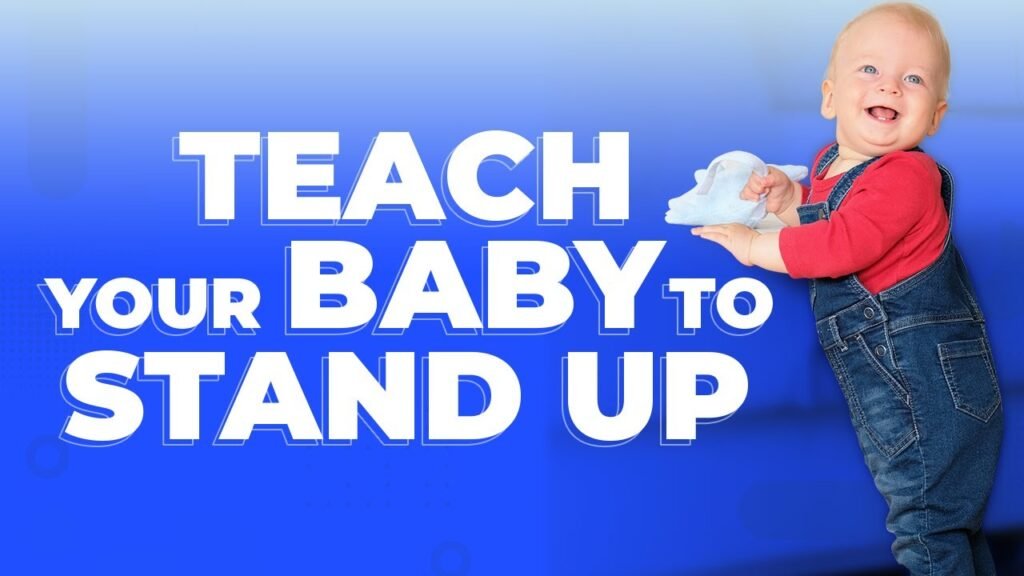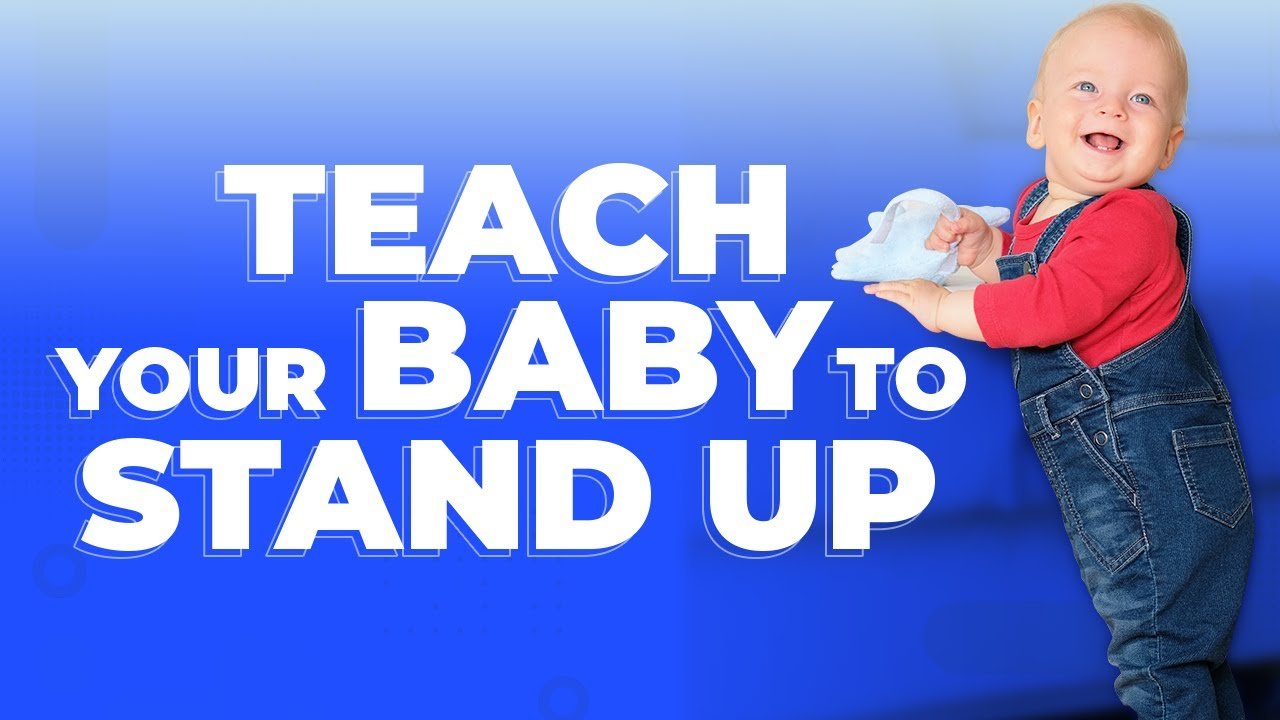Before your little one starts walking, they need to learn how to stand first. In Emma Hubbard’s video, she demonstrates three simple activities you can do at home to help your baby develop the strength and coordination needed to stand up. By following these tips, your baby will soon be on their way to taking their first steps towards independent walking.
Encouraging your baby to kneel on low surfaces and eventually on higher surfaces, as well as teaching them to stand up from your lap or the floor, are the key activities covered in the video. These activities will help your baby develop the necessary muscle strength and motor skills to pull themselves up into standing and prepare them for the exciting milestone of walking.

Encouraging Crawling Over Low Surfaces
When encouraging your baby to crawl on low surfaces, it is essential to create a safe and inviting environment for them. Placing cushions or toy boxes on the floor not only provides a comfortable crawling surface but also entices your baby to move towards them. By placing engaging toys on top of these objects, you encourage your baby to crawl towards them, gradually strengthening their muscles and coordination.
As your baby reaches the cushions or toy boxes, they will naturally take weight through their legs in a kneeling position. This movement not only reinforces their leg muscles but also helps them develop balance and stability. By allowing your baby to independently move towards enticing toys and objects, you promote their curiosity and drive to explore their surroundings.
Increasing Height of Surfaces
To further enhance your baby’s crawling and standing skills, gradually raising the height of objects for them to crawl to is essential. By increasing the challenge level, your baby learns to take more weight through their legs, strengthening their muscles and improving their coordination. Placing toys or objects at higher surfaces encourages your baby to reach up, promoting higher kneeling positions and further enhancing their strength and stability.
Encouraging your baby to crawl and kneel on higher surfaces not only challenges them physically but also boosts their confidence as they successfully navigate these obstacles. By creating a progressively more challenging environment, you enable your baby to develop the necessary skills to stand up and explore their surroundings with confidence.
Assisting Standing Up from Lap
Sitting in front of a low surface with your baby on your lap provides an excellent opportunity for them to practice standing up. By placing a toy on the surface to encourage reaching, you stimulate your baby’s interest and motivation to stand. Supporting your baby’s hip movement to stand up involves gently guiding their leg movements and providing assistance as they transition from a sitting position to standing.
By assisting your baby in standing up from your lap, you not only promote their physical development but also strengthen the bond between you and your little one. Encouraging interaction and movement in a safe and supportive manner fosters your baby’s independence and confidence in their abilities.
Guiding Half Kneeling to Standing
Once your baby is comfortable with kneeling next to furniture, guiding them from half kneeling to standing becomes the next step in their development. By applying gentle pressure to guide their leg movement and assisting them in transitioning from half kneeling to standing, you provide valuable support in mastering this skill. By encouraging your baby to practice this movement, you help them build strength and coordination necessary for standing independently.
Guiding your baby from half kneeling to standing allows them to develop their motor skills and muscle strength progressively. By offering gentle guidance and support, you empower your baby to explore new movements and challenges, fostering their physical development and coordination abilities.
Developing Strength and Coordination
Encouraging your baby to practice standing independently is crucial for their overall development. Allowing your baby to build confidence in standing and providing a safe environment for them to explore their balance and stability are essential steps in this process. By offering toys and objects for your baby to grasp while standing, you stimulate their muscle growth and coordination, further enhancing their physical abilities.
Stimulating muscle growth through standing and walking practice not only strengthens your baby’s legs and core but also improves their balance and coordination. By creating a supportive environment for your baby to explore standing, you lay the foundation for their future mobility and independence.
Supporting Falls and Tumbles
As your baby learns to stand and explore their surroundings, it is natural for them to experience falls and tumbles. Expecting your baby to fall frequently in the early stages of standing helps them develop resilience and adaptability. Ensuring a safe environment to prevent injuries is crucial in allowing your baby to explore and learn from these experiences.
Reassuring your baby and encouraging further attempts at standing after falls instills confidence and determination in them. By creating a supportive and encouraging atmosphere, you empower your baby to overcome challenges, learn from setbacks, and develop essential motor skills and coordination.
Reinforcing Motor Skills and Muscle Development
Engaging in standing activities on a regular basis is key to reinforcing your baby’s motor skills and muscle development. Offering toys and objects for your baby to grasp while standing not only enhances their coordination but also stimulates their cognitive and physical growth. By providing opportunities for your baby to practice standing and walking, you promote healthy muscle development and coordination.
Stimulating muscle growth through standing and walking practice not only strengthens your baby’s physical abilities but also enhances their cognitive and sensory skills. By incorporating standing activities into your baby’s routine, you support their overall development and lay the groundwork for future milestones.
Encouraging Independent Efforts
Allowing your baby to attempt standing without constant support is vital for fostering their independence and self-confidence. Praise and celebrate your baby’s progress in standing, acknowledging their achievements and efforts. By promoting self-confidence and autonomy, you empower your baby to explore, learn, and grow at their own pace.
By acknowledging and celebrating your baby’s achievements in standing milestones, you instill a sense of accomplishment and pride in them. Encouraging independent efforts and providing positive reinforcement create a supportive environment for your baby to thrive, learn, and develop essential skills for their future.
Monitoring Progress and Seeking Professional Advice
Tracking your baby’s development in standing milestones is crucial in understanding their progress and identifying any potential concerns. Consulting a pediatrician if you have any worries or uncertainties about your baby’s development ensures that you receive professional guidance and support. Observing your baby’s coordination and balance in standing positions helps you assess their physical abilities and address any issues early on.
Monitoring your baby’s progress and seeking professional advice when needed allows you to provide the best possible care and support for their development. By staying informed and proactive, you can address any challenges or concerns effectively, ensuring your baby’s continued growth and well-being.
Conclusion
Teaching your baby to stand is a gradual and rewarding process that requires patience, consistency, and support. By engaging in activities that promote strength, coordination, and independence, you help your baby develop essential skills for standing and walking. Celebrating your baby’s achievements in standing milestones and acknowledging their progress along the way reinforces their confidence and determination.
Consistent practice and support are key elements in guiding your baby through the stages of standing development. By creating a safe, engaging, and nurturing environment for your baby to explore and learn, you lay the foundation for their physical growth and independence. Celebrate each step of your baby’s journey in standing with joy and encouragement, knowing that you are helping them reach new heights in their development.

